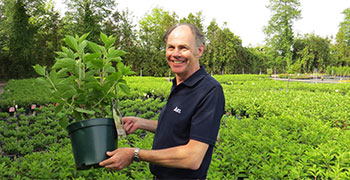Autumn cropping – plan ahead as more changes than usual
In an industry that is always looking well ahead, planning for autumn bedding and pot plant crops is already upon us. As we transition from one cropping cycle to the next, Brendan Howell, Sales Development Manager for Professional Horticulture across Ireland, says it’s a good time to think about the changes the industry has experienced over the last few months and to plan ahead to negate any negative impacts on autumn crops.

Shine a spotlight on nutrition
The last year has seen growing media undergo changes as the industry continues to reduce its reliance on peat and move to other, more sustainable, alternatives.
This trend to reduce or eliminate peat from growing media can impacts on its handling characteristics as well as its requirements for basic additives. For example, a reduction in peat content can affect the amount of lime added to the growing media mix to achieve the desired growing media pH.
Lowering the rate of magnesian limestone could impact calcium availability, which might not be noticeable in hard water areas. However, if this shortfall is not rectified on nurseries using soft water (including rainwater capture) they are likely to see a detrimental impact on crop quality.
Poinsettias are a crop well known for having a high calcium demand. However, it is also worth noting that shorter days, higher humidities and lower transpiration rates can cause calcium deficiency in a broad range of crops.
An immobile element in the plant, calcium needs to be replenished by uptake from the roots. Now is a good time to have a water analysis undertaken on your nursery and to assess if any action is required.
A detailed water analysis will help flag up any potential issues regarding water quality and nutrient availability – macro, micro and trace elements. In the case of a calcium shortfall, this could be dealt with by adding fully coated Osmocote CalMag to the growing media mix; by increasing the calcium rate in the feed tank; or by incorporating one or more Peters Excel or Universol soft water products into the nutrition programme.
Iron, another immobile nutrient, is a trace element necessary for chlorophyll production. It plays a key role in maintaining leaf colour. To ensure sufficient trace elements are available for the crop to keep plants healthy and looking their best, it may be advisable to check the rate of Micromax Premium in your growing media or apply Micromax Water Soluble TE or Micromax WS Fe to your crops.
Autumn feeding choices
Autumn crops tend to have a longer production season compared to those grown earlier in the year. This inevitably means additional fertiliser inputs are required via controlled release fertiliser (CRF) or water soluble fertilisers (WSF).
Over the past 12 months, with vastly fluctuating demand for plants, crop flexibility has grown in importance. While offering maximum flexibility, WSFs such as Peters and Universol allow growers to tailor the balance and rates applied to the crop based on its stage in the production cycle. Employing WSFs growers can ‘hold back’ or ‘advance’ crops by carefully manipulating the nutrient analysis through product choice.
However, by their nature WSFs are only applied during irrigation cycles. With the cooler, darker, damper days of autumn and winter this can lead to conflict and compromise. Growers have to decide whether to irrigate, or not, and its impact on fertiliser availability.
By incorporating CRFs, like Osmocote Exact, growers have the security that the fertiliser is always there - ‘trickle’ feeding into the pot over the full production cycle. With watering and feeding separated, they can both be managed accordingly.
Our comprehensive Osmocote range offers a wide choice of longevities and analysis. The optimum product to suit your crop can be predetermined and incorporated into the growing media mix.
Rest assured – when used correctly – controlled release fertilisers or water soluble fertilisers can both lead to healthy, vibrant and desirable plants.
Autumn, by its nature, is a season of change. With recent events reshaping the world we live in, now is perhaps a good time to stand back, take stock and check on the basics.
For bespoke advice regarding issues raised in this feature, contact Brendan Howell - [email protected].
